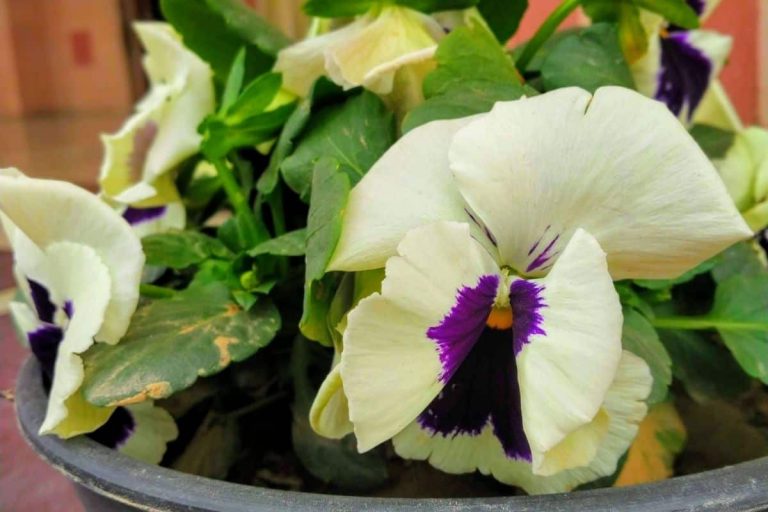Pansies are a popular cool weather flower known for their colorful, cheerful blooms However, pansies can suddenly collapse and die, leaving gardeners wondering why their pansies are failing There are several potential causes for pansies dying prematurely. By understanding the most common reasons pansies decline and implementing good care practices, you can revive and protect your pansies.
Overwatering Leads to Crown Rot
One of the most frequent reasons pansies die is overwatering which causes crown rot. The main cause of crown rot in pansies is excess moisture. Pansies will rot at the crown and die if they are constantly overwatered. Crown rot is a fungal disease that attacks right above the soil line. It thrives in warm wet conditions. The disease causes the entire plant to wilt and collapse. Once crown rot takes hold, it quickly kills pansies. To prevent crown rot, water pansies at soil level rather than overhead watering. Water deeply but infrequently, allowing the soil to dry between waterings.
Underwatering Stresses Roots
While overwatering is problematic, not watering enough can also cause pansies to fail. Pansies have shallow roots that need consistent moisture. Letting pansies dry out too much between waterings puts them under drought stress. This stunts growth and causes wilting. Water pansies when the top inch of soil becomes dry. In very hot weather, they may need daily watering. Proper mulching helps retain soil moisture.
Extreme Heat Burns Flowers
One of the biggest enemies of pansies is heat. Pansies thrive in cool weather but suffer once temperatures climb above 70°F. Hot sun scorches the blooms, causing them to shrivel and fade. Choose sites with afternoon shade to help pansies cope with heat. Watering during hot, dry spells keeps plants from wilting. You can revive heat-stressed pansies by cutting back any damaged growth. This encourages new, healthier blooms.
Poor Drainage Encourages Disease
Pansies need soil that drains well. Poor drainage keeps roots excessively wet, creating an environment perfect for root rot and other fungal issues. Improve drainage by mixing in compost when planting. Raised beds also promote drainage. If planting in heavy clay soil, choose pansy varieties specifically bred for better tolerance of wet soil. Avoid overwatering when growing pansies in poorly draining sites.
Insufficient Acidity Reduces Nutrients
Pansies require acidic soil with a pH between 5.5-5.8. Soil that is too alkaline prevents plants from accessing nutrients properly. This leads to yellowed, stunted growth. Test soil pH yearly and amend as needed to maintain acidity. Aluminum sulfate or sulfur will lower pH. Indoors, use a acidic potting mix made for acid-loving plants.
Aggressive Fertilizing Causes Legginess
While pansies need nutrients, over-fertilizing does more harm than good. Excess fertilizer causes leggy, weak growth unable to support itself. It also leaves plants prone to disease and insect damage. Use a balanced, slow-release fertilizer and follow label instructions carefully. For in-ground plants, a light spring application is sufficient. Container plants may need a second, light feeding mid-season.
Neglecting Deadheading Stalls Blooms
Pansies are prolific bloomers when properly cared for. However, leaving spent blooms on the plants prevents new buds from forming. Deadhead pansies frequently by pinching off old flowers. For best results, deadhead in the evening when cooler temperatures prevent heat stress to the plants. Consistent deadheading keeps pansies blooming strongly.
Failure to Control Pests/Disease
Pansies have several potential pest and disease problems. Aphids, slugs, snails, and fungal issues can quickly destroy pansies if left unchecked. Identify and treat any problems early before they spread. Use organic pest control methods when possible. Keep plants healthy with good cultural care to ward off pests and diseases.
Insufficient Winter Protection
In cold climates, pansies often thrive as cool weather annuals during spring and fall. They will die back with winter freezes unless special care is taken. Protect pansies through winter by covering beds with a thick mulch layer. Container plants can be moved to an unheated garage or cellar over winter. With adequate insulation, established plants will return in spring.
By understanding why pansies fail and implementing preventative care, you can keep pansies looking healthy and cheerful in your garden. Pay close attention to watering needs, fertility, deadheading spent blooms, and controlling pests. With a bit of extra care, your pansies will flourish.

Pests: Uninvited Guests on Your Wild Pansy
Munch marks: If you spot holes in your Wild Pansys leaves, youve got pests. These little vandals leave a signature trail of destruction.
Discoloration and distortion: When leaves start yellowing or growing weirdly, its not abstract art—its a pest problem.
Light and Temperature: The Balancing Act
When your Wild Pansy starts sporting pale leaves, its not trying to follow a new plant trend—its light-starved. Leggy stems? Thats your Pansys way of saying its reaching for more than what youre giving.
Too much direct sunlight and your Pansys leaves might as well be in a frying pan. Rotate your plant to prevent one side from hogging all the light, like a greedy sibling.
Garden Help: Why do my pansies and violas wilt and die off?
FAQ
What do overwatered pansies look like?
Overwatered pansies typically exhibit yellow to brown rings on the leaves, says Roethling. The leaves can also become soft and eventually fall off the plant. Overwatering can also lead to root rot and prevent growth.
How do I bring my pansies back to life?
I brought them back to life with some water and a lil sun, and she gave me all these pretty colors!!…. pansies dont like heat. they do better in cooler weather.
Why are my potted pansies wilting?
Water Stress – Both insufficient and excessive watering can lead to drooping leaves, dry soil, or overly saturated conditions.Sep 30, 2024
How do I save my pansies?
So, if you really love your pansies and violas and hate the thought of tossing them onto the compost heap when it’s time to plant other annuals, consider drying them and using them later to decorate notepaper, candles or even indoor pots. It’s easy to do, even without flower-pressing gadgets.
